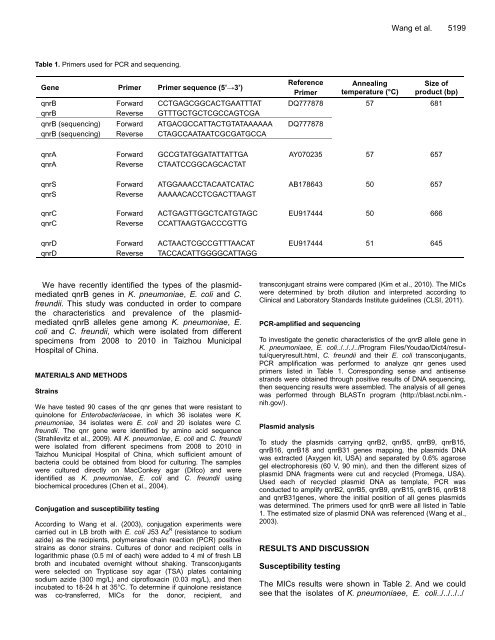Microbiology Research - Academic Journals
Microbiology Research - Academic Journals
Microbiology Research - Academic Journals
You also want an ePaper? Increase the reach of your titles
YUMPU automatically turns print PDFs into web optimized ePapers that Google loves.
Table 1. Primers used for PCR and sequencing.<br />
Gene Primer Primer sequence (5’→3’)<br />
Reference<br />
Primer<br />
Annealing<br />
temperature (°C)<br />
Wang et al. 5199<br />
Size of<br />
product (bp)<br />
qnrB Forward CCTGAGCGGCACTGAATTTAT DQ777878 57 681<br />
qnrB Reverse GTTTGCTGCTCGCCAGTCGA<br />
qnrB (sequencing) Forward ATGACGCCATTACTGTATAAAAAA DQ777878<br />
qnrB (sequencing) Reverse CTAGCCAATAATCGCGATGCCA<br />
qnrA Forward GCCGTATGGATATTATTGA AY070235 57 657<br />
qnrA Reverse CTAATCCGGCAGCACTAT<br />
qnrS Forward ATGGAAACCTACAATCATAC AB178643 50 657<br />
qnrS Reverse AAAAACACCTCGACTTAAGT<br />
qnrC Forward ACTGAGTTGGCTCATGTAGC EU917444 50 666<br />
qnrC Reverse CCATTAAGTGACCCGTTG<br />
qnrD Forward ACTAACTCGCCGTTTAACAT EU917444 51 645<br />
qnrD Reverse TACCACATTGGGGCATTAGG<br />
We have recently identified the types of the plasmid-<br />
mediated qnrB genes in K. pneumoniae, E. coli and C.<br />
freundii. This study was conducted in order to compare<br />
the characteristics and prevalence of the plasmidmediated<br />
qnrB alleles gene among K. pneumoniae, E.<br />
coli and C. freundii, which were isolated from different<br />
specimens from 2008 to 2010 in Taizhou Municipal<br />
Hospital of China.<br />
MATERIALS AND METHODS<br />
Strains<br />
We have tested 90 cases of the qnr genes that were resistant to<br />
quinolone for Enterobacteriaceae, in which 36 isolates were K.<br />
pneumoniae, 34 isolates were E. coli and 20 isolates were C.<br />
freundii. The qnr gene were identified by amino acid sequence<br />
(Strahilevitz et al., 2009). All K. pneumoniae, E. coli and C. freundii<br />
were isolated from different specimens from 2008 to 2010 in<br />
Taizhou Municipal Hospital of China, which sufficient amount of<br />
bacteria could be obtained from blood for culturing. The samples<br />
were cultured directly on MacConkey agar (Difco) and were<br />
identified as K. pneumoniae, E. coli and C. freundii using<br />
biochemical procedures (Chen et al., 2004).<br />
Conjugation and susceptibility testing<br />
According to Wang et al. (2003), conjugation experiments were<br />
carried out in LB broth with E. coli J53 Az R (resistance to sodium<br />
azide) as the recipients, polymerase chain reaction (PCR) positive<br />
strains as donor strains. Cultures of donor and recipient cells in<br />
logarithmic phase (0.5 ml of each) were added to 4 ml of fresh LB<br />
broth and incubated overnight without shaking. Transconjugants<br />
were selected on Trypticase soy agar (TSA) plates containing<br />
sodium azide (300 mg/L) and ciprofloxacin (0.03 mg/L), and then<br />
incubated to 18-24 h at 35°C. To determine if quinolone resistance<br />
was co-transferred, MICs for the donor, recipient, and<br />
transconjugant strains were compared (Kim et al., 2010). The MICs<br />
were determined by broth dilution and interpreted according to<br />
Clinical and Laboratory Standards Institute guidelines (CLSI, 2011).<br />
PCR-amplified and sequencing<br />
To investigate the genetic characteristics of the qnrB allele gene in<br />
K. pneumoniaee, E. coli../../../../Program Files/Youdao/Dict4/resultui/queryresult.html,<br />
C. freundii and their E. coli transconjugants,<br />
PCR amplification was performed to analyze qnr genes used<br />
primers listed in Table 1. Corresponding sense and antisense<br />
strands were obtained through positive results of DNA sequencing,<br />
then sequencing results were assembled. The analysis of all genes<br />
was performed through BLASTn program (http://blast.ncbi.nlm.nih.gov/).<br />
Plasmid analysis<br />
To study the plasmids carrying qnrB2, qnrB5, qnrB9, qnrB15,<br />
qnrB16, qnrB18 and qnrB31 genes mapping, the plasmids DNA<br />
was extracted (Axygen kit, USA) and separated by 0.6% agarose<br />
gel electrophoresis (60 V, 90 min), and then the different sizes of<br />
plasmid DNA fragments were cut and recycled (Promega, USA).<br />
Used each of recycled plasmid DNA as template, PCR was<br />
conducted to amplify qnrB2, qnrB5, qnrB9, qnrB15, qnrB16, qnrB18<br />
and qnrB31genes, where the initial position of all genes plasmids<br />
was determined. The primers used for qnrB were all listed in Table<br />
1. The estimated size of plasmid DNA was referenced (Wang et al.,<br />
2003).<br />
RESULTS AND DISCUSSION<br />
Susceptibility testing<br />
The MICs results were shown in Table 2. And we could<br />
see that the isolates of K. pneumoniaee, E. coli../../../../

















